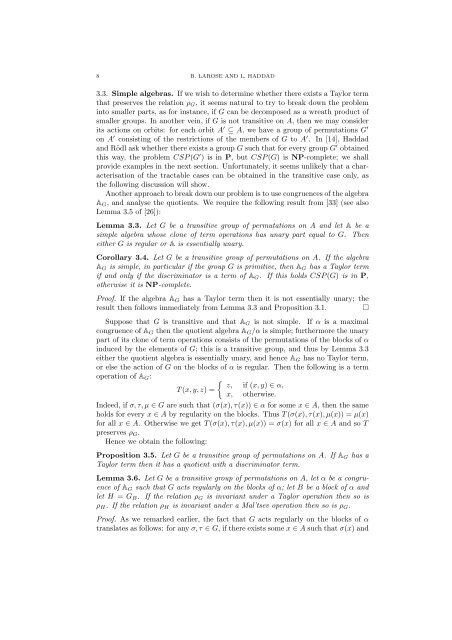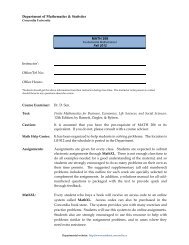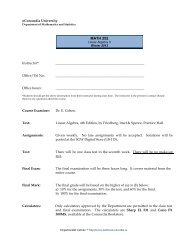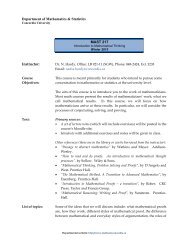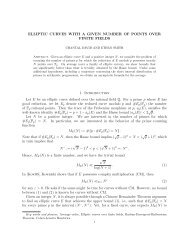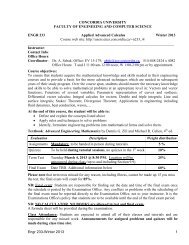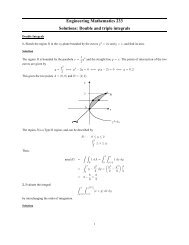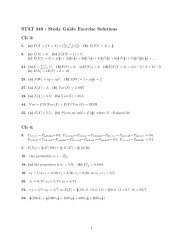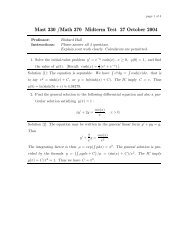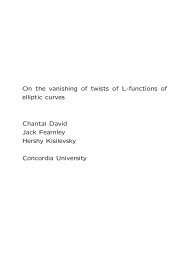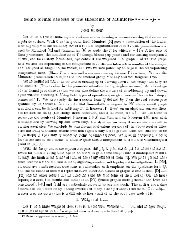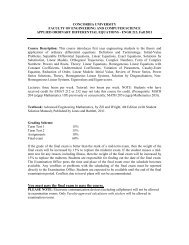COLOURINGS OF HYPERGRAPHS, PERMUTATION GROUPS ...
COLOURINGS OF HYPERGRAPHS, PERMUTATION GROUPS ...
COLOURINGS OF HYPERGRAPHS, PERMUTATION GROUPS ...
You also want an ePaper? Increase the reach of your titles
YUMPU automatically turns print PDFs into web optimized ePapers that Google loves.
8 B. LAROSE AND L. HADDAD<br />
3.3. Simple algebras. If we wish to determine whether there exists a Taylor term<br />
that preserves the relation ρ G , it seems natural to try to break down the problem<br />
into smaller parts, as for instance, if G can be decomposed as a wreath product of<br />
smaller groups. In another vein, if G is not transitive on A, then we may consider<br />
its actions on orbits: for each orbit A ′ ⊆ A, we have a group of permutations G ′<br />
on A ′ consisting of the restrictions of the members of G to A ′ . In [14], Haddad<br />
and Rödl ask whether there exists a group G such that for every group G ′ obtained<br />
this way, the problem CSP (G ′ ) is in P, but CSP (G) is NP-complete; we shall<br />
provide examples in the next section. Unfortunately, it seems unlikely that a characterisation<br />
of the tractable cases can be obtained in the transitive case only, as<br />
the following discussion will show.<br />
Another approach to break down our problem is to use congruences of the algebra<br />
A G , and analyse the quotients. We require the following result from [33] (see also<br />
Lemma 3.5 of [26]):<br />
Lemma 3.3. Let G be a transitive group of permutations on A and let A be a<br />
simple algebra whose clone of term operations has unary part equal to G. Then<br />
either G is regular or A is essentially unary.<br />
Corollary 3.4. Let G be a transitive group of permutations on A. If the algebra<br />
A G is simple, in particular if the group G is primitive, then A G has a Taylor term<br />
if and only if the discriminator is a term of A G . If this holds CSP (G) is in P,<br />
otherwise it is NP-complete.<br />
Proof. If the algebra A G has a Taylor term then it is not essentially unary; the<br />
result then follows immediately from Lemma 3.3 and Proposition 3.1. □<br />
Suppose that G is transitive and that A G is not simple. If α is a maximal<br />
congruence of A G then the quotient algebra A G /α is simple; furthermore the unary<br />
part of its clone of term operations consists of the permutations of the blocks of α<br />
induced by the elements of G; this is a transitive group, and thus by Lemma 3.3<br />
either the quotient algebra is essentially unary, and hence A G has no Taylor term,<br />
or else the action of G on the blocks of α is regular. Then the following is a term<br />
operation of A G :<br />
{<br />
z, if (x, y) ∈ α,<br />
T (x, y, z) =<br />
x, otherwise.<br />
Indeed, if σ, τ, µ ∈ G are such that (σ(x), τ(x)) ∈ α for some x ∈ A, then the same<br />
holds for every x ∈ A by regularity on the blocks. Thus T (σ(x), τ(x), µ(x)) = µ(x)<br />
for all x ∈ A. Otherwise we get T (σ(x), τ(x), µ(x)) = σ(x) for all x ∈ A and so T<br />
preserves ρ G .<br />
Hence we obtain the following:<br />
Proposition 3.5. Let G be a transitive group of permutations on A. If A G has a<br />
Taylor term then it has a quotient with a discriminator term.<br />
Lemma 3.6. Let G be a transitive group of permutations on A, let α be a congruence<br />
of A G such that G acts regularly on the blocks of α; let B be a block of α and<br />
let H = G B . If the relation ρ G is invariant under a Taylor operation then so is<br />
ρ H . If the relation ρ H is invariant under a Mal’tsev operation then so is ρ G .<br />
Proof. As we remarked earlier, the fact that G acts regularly on the blocks of α<br />
translates as follows: for any σ, τ ∈ G, if there exists some x ∈ A such that σ(x) and


